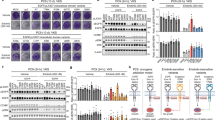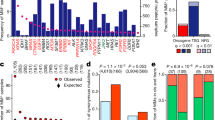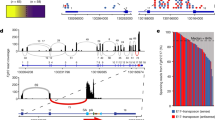Abstract
Doublet mutations in cancer are not well studied. We find that allelic somatic doublet mutations are present at high frequency in the epidermal growth factor receptor (EGFR) tyrosine kinase (TK) domain in lung cancers. When doublets from the literature are added, a total of 96 doublets are available for analysis. The frequency of doublets overall is 6%, which is sevenfold greater than that observed in normal tissue in mouse. All characterized doublets are allelic, and silent mutations occur rarely. About half of all doublets contain one or two of 12 distinct missense mutations at five amino acids: E709, G719, S768, T790 and L861. The mutations at these five amino acids are seldom reported as singlets. Moreover, when the common L858 target is included, more than one-third of EGFR doublets are one of five specific missense pairs: G719/E709, G719/S768, G719/L861, L858/E709 and L858/T790. Structure suggests function: The data imply that most EGFR doublets are NOT consistent with a ‘driver and passenger’ mutation mechanism. EGFR doublets are highly skewed relative to singlets, consistent with functional selection of two individually suboptimal mutations that, in combination, have enhanced oncogenic potential.
This is a preview of subscription content, access via your institution
Access options
Subscribe to this journal
Receive 50 print issues and online access
$259.00 per year
only $5.18 per issue
Buy this article
- Purchase on Springer Link
- Instant access to full article PDF
Prices may be subject to local taxes which are calculated during checkout

Similar content being viewed by others
References
Arteaga CL . (2002). Overview of epidermal growth factor receptor biology and its role as a therapeutic target in human neoplasia. Semin Oncol 29: 3–9.
Bell DW, Gore I, Okimoto RA, Godin-Heymann N, Sordella R, Mulloy R et al. (2005). Inherited susceptibility to lung cancer may be associated with the T790M drug resistance mutation in EGFR. Nat Genet 37: 1315–1316.
Buettner VL, Hill KA, Halangoda A, Sommer SS . (1999). Tandem-based mutations occur in mouse liver and adipose tissue preferentially as G:C to T:A transversions and accumulate with age. Environ Mol Mutagen 33: 320–324.
Buettner VL, Hill KA, Scaringe WA, Sommer SS . (2000). Evidence that proximal multiple mutations in Big Blue transgenic mice are dependent events. Mutat Res 452: 219–229.
Chen YR, Fu YN, Lin CH, Yang ST, Hu SF, Chen YT et al. (2006). Distinctive activation patterns in constitutively active and gefitinib-sensitive EGFR mutants. Oncogene 25: 1205–1215.
Davies H, Hunter C, Smith R, Stephens P, Greenman C, Bignell G et al. (2005). Somatic mutations of the protein kinase gene family in human lung cancer. Cancer Res 65: 7591–7595.
Godin-Heymann N, Bryant I, Rivera MN, Ulkus L, Bell DW, Riese DJ et al. (2007). Oncogenic activity of epidermal growth factor receptor kinase mutant alleles is enhanced by the T790M drug resistance mutation. Cancer Res 67: 7319–7326.
Greenman C, Stephens P, Smith R, Dalgliesh GL, Hunter C, Bignell G et al. (2007). Patterns of somatic mutation in human cancer genomes. Nature 446: 153–158.
Gu D, Scaringe WA, Li K, Saldivar JS, Hill KA, Chen Z et al. (2007). Database of somatic mutations in EGFR with analyses revealing indel hotspots but no smoking-associated signature. Hum Mutat 28: 760–770.
Hill KA, Wang J, Farwell KD, Sommer SS . (2003). Spontaneous tandem-base mutations (TBM) show dramatic tissue, age, pattern and spectrum specificity. Mutat Res 534: 173–186.
Hill KA, Wang J, Farwell KD, Scaringe WA, Sommer SS . (2004). Spontaneous multiple mutations show both proximal spacing consistent with chronocoordinate events and alterations with p53-deficiency. Mutat Res 554: 223–240.
Lynch TJ, Bell DW, Sordella R, Gurubhagavatula S, Okimoto RA, Brannigan BW et al. (2004). Activating mutations in the epidermal growth factor receptor underlying responsiveness of non-small-cell lung cancer to gefitinib. N Engl J Med 350: 2129–2139.
Ma ES, Wong CL, Siu D, Chan WK . (2007). Amplification, mutation and loss of heterozygosity of the EGFR gene in metastatic lung cancer. Int J Cancer 120: 1828–1831.
Mulloy R, Ferrand A, Kim Y, Sordella R, Bell DW, Haber DA et al. (2007). Epidermal growth factor receptor mutants from human lung cancers exhibit enhanced catalytic activity and increased sensitivity to gefitinib. Cancer Res 67: 2325–2330.
Paez JG, Janne PA, Lee JC, Tracy S, Greulich H, Gabriel S et al. (2004). EGFR mutations in lung cancer: correlation with clinical response to gefitinib therapy. Science 304: 1497–1500.
Regales L, Balak MN, Gong Y, Politi K, Sawai A, Le C et al. (2007). Development of new mouse lung tumor models expressing EGFR T790M mutants associated with clinical resistance to kinase inhibitors. PLoS ONE 2: e810.
Saldivar JS, Chen Z, Sommer SS . (2006). Current Protocols in Human Genetics In: Haines JL, Korf BR, Morton CC, Seidman JG, Smith DR (eds). John Wiley & Sons, Inc., Hoboken, NJ, USA, Unit 10.9, pp 1–14.
Shigematsu H, Gazdar AF . (2005a). Somatic mutations of epidermal growth factor receptor signaling pathway in lung cancers. Int J Cancer 118: 257–262.
Shigematsu H, Lin L, Takahashi T, Nomura M, Suzuki M, Wistuba II et al. (2005b). Clinical and biological features associated with epidermal growth factor receptor gene mutations in lung cancers. J Natl Cancer Inst 97: 339–346.
Shintani S, Kiyota A, Mihara M, Sumida T, Kayahara H, Nakashiro K et al. (2003). Enhancement of radiosensitivity in head and neck cancer cells by ZD1839 (‘IRESSA’), a selective epidermal growth factor receptor tyrosine kinase inhibitor. Am J Clin Oncol 26: e150–e156.
Sjoblom T, Jones S, Wood LD, Parsons DW, Lin J, Barber TD et al. (2006). The consensus coding sequences of human breast and colorectal cancers. Science 314: 268–274.
Sommer SS, Cohen JE . (1980). The size distributions of proteins, mRNA, and nascent transcripts. J Mol Evol 15: 37–57.
Sommer SS, Groszbach AR, Bottema CDK . (1992). PCR amplification of specific alleles (PASA) is a general method for rapidly detecting known single-base changes. BioTechniques 12: 82–87.
Sordella R, Bell DW, Haber DA, Settleman J . (2004). Gefitinib-sensitizing EGFR mutations in lung cancer activate anti-apoptotic pathways. Science 305: 1163–1167.
Strauss BS . (1997). Silent and multiple mutations in p53 and the question of the hypermutability of tumors. Carcinogenesis 18: 1445–1452.
Strauss BS . (2000). Role in tumorigenesis of silent mutations in the TP53 gene. Mutat Res 457: 93–104.
Takano T, Ohe Y, Sakamoto H, Tsuta K, Matsuno Y, Tateishi U et al. (2005). Epidermal growth factor receptor gene mutations and increased copy numbers predict gefitinib sensitivity in patients with recurrent non-small-cell lung cancer. J Clin Oncol 23: 6829–6837.
Tam IY, Chung LP, Suen WS, Wang E, Wong MC, Ho KK et al. (2006). Distinct epidermal growth factor receptor and KRAS mutation patterns in non-small cell lung cancer patients with different tobacco exposure and clinicopathologic features. Clin Cancer Res 12: 1647–1653.
Vikis H, Sato M, James M, Wang D, Wang Y, Wang M et al. (2007). EGFR-T790M is a rare lung cancer susceptibility allele with enhanced kinase activity. Cancer Res 67: 4665–4670.
Yokoyama T, Kondo M, Goto Y, Fukui T, Yoshioka H, Yokoi K et al. (2006). EGFR point mutation in non-small cell lung cancer is occasionally accompanied by a second mutation or amplification. Cancer Sci 97: 753–759.
Yun CH, Boggon TJ, Li Y, Woo MS, Greulich H, Meyerson M et al. (2007). Structures of lung cancer-derived EGFR mutants and inhibitor complexes: mechanism of activation and insights into differential inhibitor sensitivity. Cancer Cell 11: 217–227.
Acknowledgements
We thank Dr Carolyn Buzin for critical reading and help with revision of the manuscript and Wenyan Li and Jiesheng Chen for DNA sequencing. This work is partially supported by NIH R01-AG19784-02.
Author information
Authors and Affiliations
Corresponding author
Additional information
Supplementary Information accompanies the paper on the Oncogene website (http://www.nature.com/onc).
Supplementary information
Rights and permissions
About this article
Cite this article
Chen, Z., Feng, J., Saldivar, JS. et al. EGFR somatic doublets in lung cancer are frequent and generally arise from a pair of driver mutations uncommonly seen as singlet mutations: one-third of doublets occur at five pairs of amino acids. Oncogene 27, 4336–4343 (2008). https://doi.org/10.1038/onc.2008.71
Received:
Revised:
Accepted:
Published:
Issue Date:
DOI: https://doi.org/10.1038/onc.2008.71
Keywords
This article is cited by
-
Pan-cancer clinical impact of latent drivers from double mutations
Communications Biology (2023)
-
Phase and context shape the function of composite oncogenic mutations
Nature (2020)
-
Clinical outcome of treatment of metastatic non-small cell lung cancer in patients harboring uncommon EGFR mutation
BMC Cancer (2019)
-
From cancer genomes to cancer models: bridging the gaps
EMBO reports (2009)
-
Disruption of the EGFR E884–R958 ion pair conserved in the human kinome differentially alters signaling and inhibitor sensitivity
Oncogene (2009)



